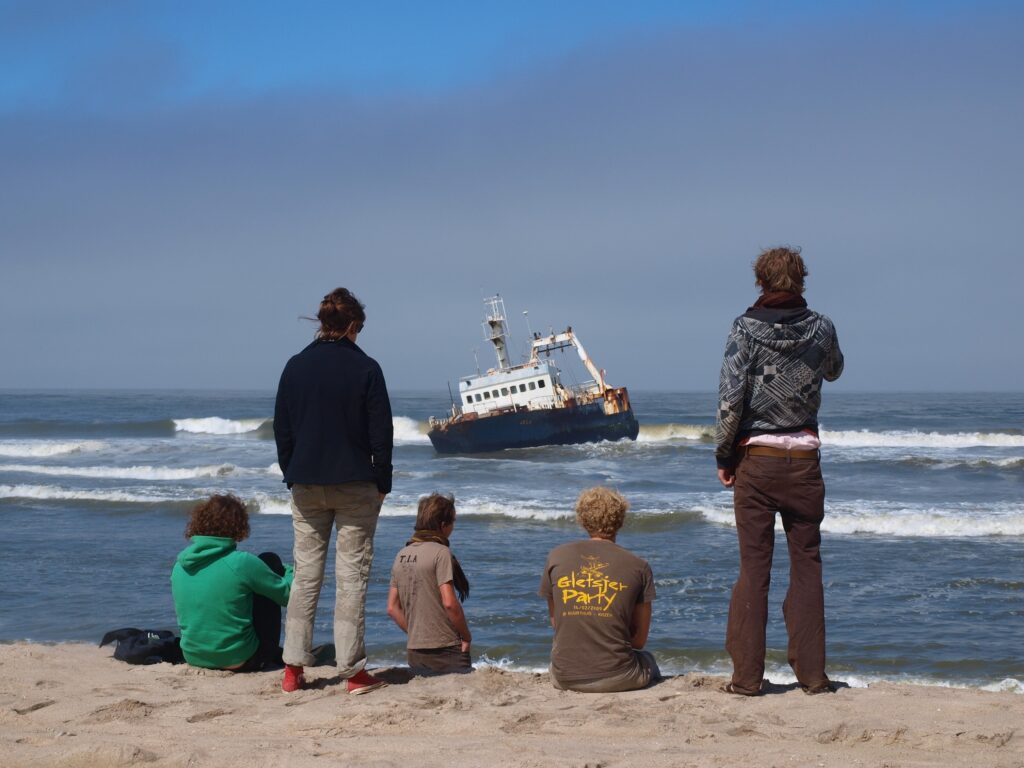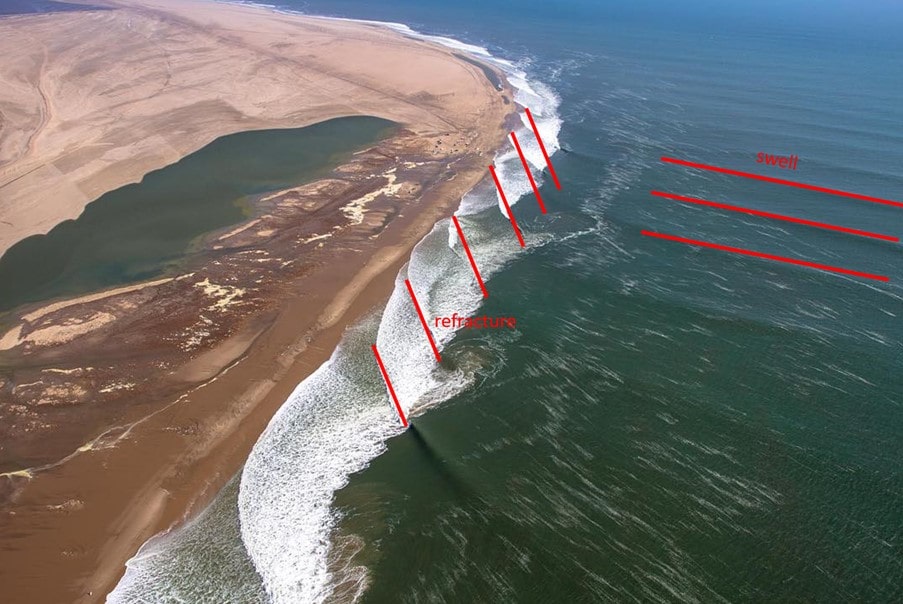At AllWaves, we have the knowledge & technology to create any wave we like. In doing so, we are inspired by nature. In this series, we will explain how the world’s most famous waves such as Skeleton Bay came to be. This time, we explain the waves at Skeleton Bay Namibia. By understanding the science behind the (water)curtain, we can create our own custom waves in our wavepool. In conclusion: read further if you want to look smart to your friends.
Location
The name Skeleton Coast in Namibia speaks to our imagination. It is named after the remains of whales & seals from the whaling industry and over 500 shipwrecks finding their final resting spot. The Skeleton Coast in Nambia is the world’s 3rd most sharkiest spot according to StabMag. It is home to 11 types of sharks and lions prowling the beaches. It is desolate, and the upwelling of the cold Benguela current clouds the coastline in dense ocean fogs for much of the year. Add to that strong currents & heavy white waters, it is understandable, Portuguese sailors once referred to it as “The Gates of Hell”.

So why is it that surfers are drawn to this coastline? Somewhere along the Skeleton Coast, you will find Skeleton Bay. Its vague & scary name is given to hide its exact location along the coast & deter tourists. Is it working? Not so much. Hundreds of surfers have meanwhile tried to surf this challenging wave only suited for experienced surfers.
Why is that? Because it is home to 2km of picture-perfect draining barrels. It is heavy, fast, only ankle deep and the best barrel you will ever lay your eyes on. Koa Smith calls it “like Teahupo’o on sand.”
History & future of Skeleton Bay
Skeleton Bay’s banks are believed to have only started building up at the end of the 70’s when Namibia’s predominant south winds altered by 20 degrees, which in turn changed currents and sand movement.
This caused a nook along the coastline and allowed sand to collect, forming the ridiculously long sand bank point we know today.
Satellite images show its evolution since the 70s. In 1973 the shoreline at Skeleton Bay was an incredible 1km further south than it currently sits. It is growing northwards 20 m per year.

However, Skeleton Bay was only “discovered” by the global community in 2008 when Surfing Magazine (R.I.P.) ran the Google Earth Challenge. For this competition, people were invited to “discover” a spot through a new tool at the time called “Google Earth”.
The picture below shows how sand deposits from South swells are making the “neck” thinner & longer, which may cause a breach in the future (red highlights). This would endanger the harbour of Walvis Bay. Which is the most important harbour in the region and is now sheltered by this natural jetty. The best method for protecting Walvis Bay and stabilising Pelican Point is an ongoing removal of sand from the ever-growing tip of the point and moving it to reinforce where the spit is being compromised. The Walvis Bay Climate Resilience Handbook proposes this approach but so far no actions have been taken yet. Thus the wave is in constant evolution, it can be that it disappears, or with actions taken by the Walvis Bay Municipality is kept in its perfect condition as it was in its legendary summer of 2014.

Refraction
We explained in a previous post how water particles in ocean waves move in an orbital motion. The water column in which the orbital motion moves persists as deep as half the wave length; this is how waves can “feel” the bottom of the ocean. When there’s a shallower part in the ocean floor, the orbital motion experiences friction from the seabed and slows down the wave. However, the section of the wave that doesn’t encounter this shallow spot, continues at the same speed. The difference in speed & the subsequent ‘fracturing’ of the wave is a phenomenon called “refraction”. That’s why you see waves bend-off towards the beach even when the waves come from the side in a 90 degrees angle.

Refraction is exactly the nature phenomenon happening at Skeleton Bay. Swell comes in from the South and bends along the coast in a nearly 45 degree angle. It only works if the swell has a long enough period. So that the orbital motion comes deep enough “feels” the sandbanks at the shore and starts bending. This gives it enough time to make the entire turn and start breaking. Similarly, at AllWaves, we are inspired by nature and this effect, and use refraction to create the waves at our pointbreaks.

Wave power
You can tell how powerful the wave is by its water volume. Like you see on the picture below of Koa Smith, it has no “back” drop behind the wave. It’s just a solid water mass moving in orbital motion. Because of its size, the wave has tremendous “sucking” power. It sucks the shallow water towards it in its orbital motion and creates almost a “square” wave.
For a “normal” mortal surfer to understand what it is really like surfing at Skeleton Bay, we recommend this video from Koa Smith: 1 wave, 8 barrels.

In conclusion, we would suggest surfing barrels in a wavepool, to keep it safer & much cheaper than traveling to Namibia 😉.
So what’s in it for AllWaves?
At AllWaves, we are inspired by these creations & forces of nature. Therefore, we made sure we can pre-condition waves with our proprietary algorithm & wavemaker. This means we cannot only choose height, but also shape & speed. This results in endless combinations and really the possibility to create “all waves” for all surfers. That’s the reason we call our employees “waveshapers”. The unique bathymetry of an AllWaves wavepool is patented and ensures high-quality waves by meanwhile dissipating the remaining energy to avoid backwash.
Hope you enjoyed our read,
Keep surfing (& dreaming)!
Sources used:
https://www.swellnet.com/news/swellnet-analysis/2022/09/28/decade-shape-shifting-skeleton-bay


